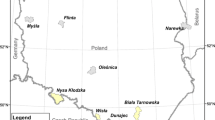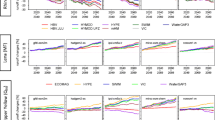Abstract
The first part of this paper demonstrated the existence of bias in GCM-derived precipitation series, downscaled using either a statistical technique (here the Statistical Downscaling Model) or dynamical method (here high resolution Regional Climate Model HadRM3) propagating to river flow estimated by a lumped hydrological model. This paper uses the same models and methods for a future time horizon (2080s) and analyses how significant these projected changes are compared to baseline natural variability in four British catchments. The UKCIP02 scenarios, which are widely used in the UK for climate change impact, are also considered. Results show that GCMs are the largest source of uncertainty in future flows. Uncertainties from downscaling techniques and emission scenarios are of similar magnitude, and generally smaller than GCM uncertainty. For catchments where hydrological modelling uncertainty is smaller than GCM variability for baseline flow, this uncertainty can be ignored for future projections, but might be significant otherwise. Predicted changes are not always significant compared to baseline variability, less than 50% of projections suggesting a significant change in monthly flow. Insignificant changes could occur due to climate variability alone and thus cannot be attributed to climate change, but are often ignored in climate change studies and could lead to misleading conclusions. Existing systematic bias in reproducing current climate does impact future projections and must, therefore, be considered when interpreting results. Changes in river flow variability, important for water management planning, can be easily assessed from simple resampling techniques applied to both baseline and future time horizons. Assessing future climate and its potential implication for river flows is a key challenge facing water resource planners. This two-part paper demonstrates that uncertainty due to hydrological and climate modelling must and can be accounted for to provide sound, scientifically-based advice to decision makers.
Similar content being viewed by others
References
Alcamo J, Moreno JM, Nováky B, Bondi M, Corobov R, Devoy RJN, Giannakopoulos C, Martin E, Olesen JE, Shividenko A (2007) Europe. In: Parry ML, et al. (eds) Climate change 2007: impacts, adaptation and vulnerability. Contribution of working group II to the fourth assessment report of the intergovernmental panel on climate change. Cambridge University Press, UK, Cambridge, pp 541–580
Allen RG, Pereira LS, Raes D, Smith M (1998) Crop evapotranspiration– guidelines for computing crop water requirements. FAO Irrigation and drainage paper vol 56
Allen RG, Smith M, Pereira LS, Perrier A (1994) An update for the calculation of reference evapotranspiration. ICID Bulletin
Arnell NW (2004) Climate change and global water resources: SRES emissions and socio-economic scenarios. Glob Environ Change 14:31–52
Arnell NW, Delaney EK (2006) Adapting to climate change: public water supply in England and Wales. Clim Change V78:227–255
Ashley RM, Balmforth DJ, Saul AJ, Blanskby JD (2005) Flooding in the future - predicting climate change, risks and responses in urban areas. Water Sci Technol 52:265–273
Booij MJ (2005) Impact of climate change on river flooding assessed with different spatial model resolutions. J Hydrol 303:176–198
Dibike YB, Coulibaly P (2005) Hydrologic impact of climate change in the Saguenay watershed: comparison of downscaling methods and hydrologic models. J Hydrol 307:145-163
Environment Agency (2001) Water resources for the future—a strategy for England and Wales. Environment Agency, p 36
Environment Agency (2003) Water Resources Planning Guidelines. Version 3.2, Environment Agency. Bristol
Fowler H, Kilsby C (2007) Using regional climate model data to simulate historical and future river flows in northwest England. Clim Change 80:337–367
Hay LE, Wilby RL, Leavesley GH (2000) Comparison of delta change and downscaled GCM scenarios for three mountainous basins in the United States. J Am Water Resour Assoc 36:387–397
Haylock MR, Cawley GC, Harpham C, Wilby RL, Goodess CM (2006) Downscaling heavy precipitation over the United Kingdom: a comparison of dynamical and statistical methods and their future scenarios. Int J Climatol 26:1397–1415
Hulme M, Jenkins GJ, Lu X, Turnpenny JR, Mitchell TD, Jones RG, Lowe J, Murphy JM, Hassell D, Boorman P, McDonald R, Hill S (2002) Climate change scenarios for the United Kingdom: the UKCIP02 scientific report. Tyndall Centre for Climate Change Research, School of Environmental Sciences, Norwhich, p 120
IPCC (2000) Special report on emissions scenarios (SRES): a special report of working group III of the intergovernmental panel on climate change. Cambridge University Press, Cambridge, p 599
Kay A, Reynard N, Jones RN (2006) RCM rainfall for UK flood frequency estimation. II. Climate change results. J Hydrol 318:163–172
Kitoh A, Hosaka M, Adachi Y, Kamiguchi K (2005) Future projections of precipitation characteristics in East Asia simulated by the MRI CGCM2. Adv Atmos Sci 22:467–478
Le Treut H (2003) Les scenarios globaux de changement climatique et leurs incertitudes: global scenarios of climate change and associated uncertainties. Comptes Rendus Geosciences 335:525–533
Marsh TJ, Lees ML (Eds.) (2003) Hydrological data UK - Hydrometric register and statistics 1996–2000, Centre for Ecology and Hydrology, Wallingford, p 208
Maurer EP, Duffy PB (2005) Uncertainty in projections of streamflow changes due to climate change in California. Geophys Res Lett, 32(3)
Miller K, Yates D (2005) Climate change and water ressources: a primer for municipal water providers. National Centre for Atmospheric Research, Boulder, p 83
Moore RJ (1985) The probability-distributed principle and runoff production at point and basin scales. Hydrol Sci J 30:273–297
Niel H, Paturel JE, Servat E (2003) Study of parameter stability of a lumped hydrologic model in a context of climatic variability. J Hydrol 278:213–230
Prudhomme C, Davies H (2009) Assessing uncertainties in climate change impacts analyses on the river flow regimes in the UK. Part 1: baseline climate. Clim Change. doi:10.1007/s10584-008-9464-3
Salinger MJ (2005) Climate variability and change: past, present and future—an overview. Clim Change 70:9–29
Stainforth DA, Aina T, Christensen C, Collins M, Faull N, Frame DJ, Kettleborough JA, Knight S, Martin A, Murphy JM, Piani C, Sexton D, Smith LA, Spicer RA, Thorpe AJ, Allen MR (2005) Uncertainty in predictions of the climate response to rising levels of greenhouse gases. Nature 433:403–406
Trenberth KE (1998) Atmospheric moisture residence times and cycling: implications for rainfall rates and climate change. Clim Change 39:667–694
UKWIR (2003) Effect of climate change on river flows and groundwater recharge UKCIP02 scenarios. UKWIR Report 03/CL/04/2
UKWIR (2007) Effects of climate change on river flows and groundwater recharge: guidelines for resource assessment and UKWIR06 scenarios. UKWIR Report 06/CL/04/8, p 84
UKWIR and Environment Agency (1997) Effects of climate change on river flows and groundwater recharge: guidelines for resource assessment, p 32
Wilby RHL (2005) Uncertainty in water resource model parameters used for climate change impact assessment. Hydrol Process 19:3201-3219
Young AR (2002) River flow simulation within ungauged catchments using a daily rainfall-runoff model. BHS Occasional Paper, vol 13, pp 23–30
Young AR (2006) Stream flow simulation within UK ungauged catchments using a daily rainfall-runoff model. J Hydrology 320:155-172
Author information
Authors and Affiliations
Corresponding author
Rights and permissions
About this article
Cite this article
Prudhomme, C., Davies, H. Assessing uncertainties in climate change impact analyses on the river flow regimes in the UK. Part 2: future climate. Climatic Change 93, 197–222 (2009). https://doi.org/10.1007/s10584-008-9461-6
Received:
Accepted:
Published:
Issue Date:
DOI: https://doi.org/10.1007/s10584-008-9461-6




